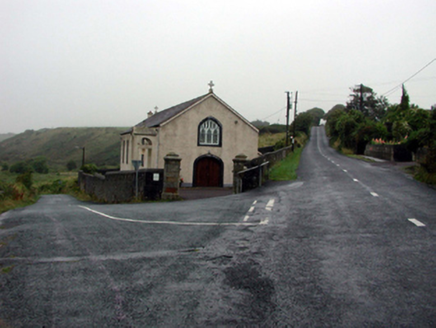Survey Data
Reg No
22812019
Rating
Regional
Categories of Special Interest
Architectural, Historical, Social
Original Use
Building misc
In Use As
Church/chapel
Date
1840 - 1845
Coordinates
244084, 99290
Date Recorded
31/07/2003
Date Updated
--/--/--
Description
Detached six-bay double-height temperance hall, built 1842. Renovated and extended, 1854, comprising four-bay double-height lean-to lower parallel range to east, and single-bay double-height lower chancel to north having single-bay single-storey lean-to sacristy to north-east to accommodate use as Catholic church. Mostly refenestrated, pre-1999. Pitched slate roofs (lean-to to parallel range and to sacristy) with clay ridge tiles, roughcast chimney stack, cross finials to apexes, and replacement uPVC rainwater goods, pre-1999, on timber eaves. Painted roughcast walls. Square-headed window openings to nave with stone sills, and replacement uPVC casement windows, pre-1999. Pointed-arch window openings to north and to south with cut-stone surrounds having chamfered reveals. Fixed-pane timber windows in tripartite arrangement having lancet-lights, and diamond-leaded fittings. Four centred-arch door opening with cut-stone surround, and replacement tongue-and-groove timber panelled double doors, pre-1999. Full-height interior open into roof with carved timber pews, open timber roof construction, and carved timber fittings to chancel (including communion rail, pulpit, and altar). Set back from line of road in own grounds on a wedge-shaped site parallel to roads with tarmacadam grounds to site. Gateway, 1842, to south comprising pair of cut-stone piers with profiled capping, and random rubble stone boundary wall to perimeter.
Appraisal
An appealing building of irregular form and massing, which is of initial significance for its original intended use as a meeting point for employees of the nearby Tankardstown Copper Mines (22902504/WD-25-04), and as a relief project during the Great Famine (1845 – 1849). Modified and adapted to use as a Catholic church in the mid nineteenth century, the building has subsequently been well maintained to present an early aspect, although the inappropriate replacement fittings to the openings have undermined some of the character of the site. Features of significance to the interior include fine timber joinery of artistic design distinction, together with an exposed timber roof construction, which is of some technical interest. Positioned at the junction of two roads, the church forms a prominent and attractive landmark in the locality.









